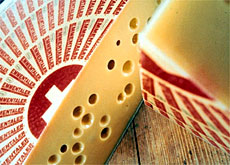The Emmental rediscovers its culinary roots

Restaurants in the Emmental region are bucking the fast-food trend by promoting traditional fare made only with local ingredients.
swissinfo’s Dale Bechtel spent a day travelling through the agricultural region, stopping off at places displaying the Emmental “Ruschtig” label – a guarantee of home-grown, quality produce.
My first port of call was the “Landgasthof Bären” in the town of Sumiswald, deep in the heart of the Emmental, which was the setting for 19th century novelist Jeremias Gotthelf’s classic work of fiction, “The Black Spider”.
But the restaurant’s role in literary history was merely a light “hors d’oeuvre” ahead of the real purpose for my visit.
I was more interested in sampling the ingredients that have put the Bären on the culinary map, and discovering more about “Ruschtig” (meaning “product or goods” in the local dialect) from the president of the Ruschtig association, Fritz von Gunten.
While I went for a lamb dish accompanied by fresh vegetables and mashed potatoes in a saffron sauce, von Gunten chose a plate of blood sausage.
He says that to meet the Ruschtig standard, at least 80 per cent of the ingredients have to be grown or raised on farms in the Emmental.
The association counts about 100 members, including restaurants, bakeries, butchers, flourmills and dairies.
“The main aim is to promote locally-produced goods in order to guarantee the economic survival of farmers, butchers or bakers,” explains von Gunten.
This is the key to the Ruschtig strategy, since around two-thirds of the Emmental workforce is still employed in agriculture.
Taste for region
Von Gunten adds that it is also a way of promoting tourism, to ensure that visitors to the region east of Bern develop a “taste” for the Emmental that will bring them back again and again.
After lunch, I wandered into the kitchen where Ferdinand Hiltbrunner, the Bären’s head chef, told me that ensuring the 80 per cent minimum is no mean feat, especially when it comes to finding vegetables in winter.
He says he can get carrots, celery and cabbage from local farms all year round, and makes sure they go a long way.
By using local goods, Hiltbrunner insists he is able to count on the high quality dairy products the region is known for – including its world famous cheese.
Wheat
After lunch, I dashed off for my next appointment. After driving through a narrow side valley sheltered by a dense pine forest, I arrived at the village of Ruegsbach and its local flourmill, the Mühle Kleeb.
Besides milling commercial wheat, it specialises in making flour, noodles and Muesli cereal from spelt – one of the first grains grown by farmers 5,000 years ago.
Hanni Kleeb, who runs the mill along with her husband, informed me that it was the only grain – together with rye – that was grown in the Emmental 100 years ago.
Spelt is naturally high in fibre and contains a lot more protein than wheat. Its tough husk makes it more difficult to process than modern wheat varieties, but it has made a comeback in the Emmental, where Kleeb says about half of all wheat farmers grow spelt.
“The minerals are in the whole grain, whereas in wheat or other grains it’s just in the outer shell,” says Kleeb. “So if you eat a white bread made with spelt, for example, it is still nutritious.”
Rösti
In nearby Grosshöchstetten, Heinz Stucki, owner and chef at the “Gasthof zur Sonne”, was preparing a simple fried potato dish called Rösti over an open flame on an oven that dates back to 1926.
Stucki has been rediscovering traditional means of food preparation. He makes every hot dish over an open flame, spices them with natural crystal salt and makes his own unfiltered vinegar.
In the restaurant’s basement, Stucki bottles his own wide assortment of brandies and liqueurs made from the fruits of the Emmental. They all boast the Ruschtig label.
He says he buys his apples, pears and plums from local farmers, and prefers old apple varieties to distil his apple schnapps.
“We pay more for the apples in order to motivate the farmers to plant the older varieties,” he says. “This helps preserve the image most people have of the Emmental countryside.”
Water buffalo
But that image has changed slightly in the fields around the village of Schangnau, at the eastern end of the Emmental, where a herd of water buffalo can be found grazing.
Farmers in the valley began raising water buffalo about six years ago to make mozzarella cheese. Their aim was to develop a new niche in the market in the face of declining exports of typical Emmental cheese.
According to cheese maker Michael Jaun, mozzarella was originally made from buffalo milk.
“It has more flavour than cow milk mozzarella, so you don’t really need to add any herbs or spices,” reveals Jaun.
Even Jaun’s mozzarella is a Ruschtig product.
swissinfo, Dale Bechtel
The “Ruschtig” label is awarded to products made with at least 80 per cent local ingredients.
About 100 restaurants, shops and suppliers are members of the Ruschtig association.
Products range from traditional meals to schnapps and mozzarella cheese made from water buffalo milk.

In compliance with the JTI standards
More: SWI swissinfo.ch certified by the Journalism Trust Initiative











You can find an overview of ongoing debates with our journalists here . Please join us!
If you want to start a conversation about a topic raised in this article or want to report factual errors, email us at english@swissinfo.ch.